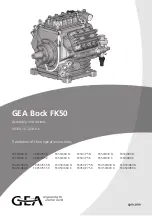
D–EIMWC00808-16HU - 3/64
IMPORTANT
The units described in the present manual represent a valuable investment. Maximum care should be taken to ensure correct
installation and appropriate working conditions of the units.
THIS
MANUAL,
WIRING
DIAGRAMS
AND
DIMENSIONAL
DRAWINGS
MUST
BE
CONSIDERED
ESSENTIALS,
KEEP
A
COPY
OF
THESE
DOCUMENTS
ALWAYS
AVAILABLE
INSIDE
THE
UNIT.
Installation and maintenance must be performed by qualified and specifically trained personnel only.
Correct maintenance of the unit is indispensable for its safety and reliability. Manufacturer’s service centres are the only having
adequate technical skill for maintenance.
The unit is made of metal, plastic and electronic parts. All of these components must be disposed of in accordance with local
disposal laws and if in scope with the national laws implementing the Directive 2012/19/EU (RAEE).
Lead batteries must be collected and sent to specific waste collection centres.
Avoid the escape of refrigerant gases into the environment by using suitable pressure vessels and tools for transferring the fluids
under pressure. This operation must be carried out by qualified personnel in refrigeration systems and in compliance with the
laws in force in the country of installation.
IMPORTANT
READ THIS DOCUMENT IN ITS ENTIRETY BEFORE BEGINNING ANY WORK ON THE UNIT.
ALL FEDERAL, STATE, LOCAL ENVIRONMENTAL AND SAFETY REGULATIONS INCLUDING DAIKIN
SAFETY RULES MUST BE FOLLOWED.
All appropriate Personal Protective Equipment (“PPE”) must be used, and a Job Hazard Analysis (“JHA”) must be completed,
before beginning any work on the unit.
Technicians performing this work must be properly trained on Daikin WSC, WDC, DWSC, DWDC Centrifugal equipment.
Important Note: In case of any procedure requires accessing the refrigerant circuit of these units, remember that refrigerant is under
pressure and oils are contained in these circuits.
Ensure that all appropriate pump-down or pump-out service valves are in the correct position, open or closed as required and
holding.
Solenoid valves and expansion valves can trap refrigerant and oils, these devices must be operated manually to release any trapped
gases and oils while in pump-down or pump-out operation.
All refrigerant lines and components of the unit must be evacuated to at least 30 kPa vacuum and verified before opening any
charging valves, venting schrader valves or testing ports.
These devices must be open and vented while accessing the refrigerant system. In some cases, cross connection lines may be
required to ensure recovery of all refrigerant in all sections of the affected system or components.



































